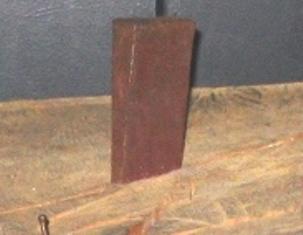Wedge
Production date
Circa 1870-1910
See full details
Object detail
Accession number
2005.44
Description
Iron wedge, circa 1870-1910 (The height of the Kauri industry in New Zealand).
One use of the iron wedge was in the felling of the tree. The bushman would choose the most convenient direction for the tree to fall and then, using an axe, would chop a wedge-shaped cut (a 'scarf') in the base of the trunk. The tree would then be sawn, usually by 2 men on a cross-cut saw, and as the saw cut deeper, a wedge was driven in behind the saw. This opened up the cut and stopped the saw becoming jammed. It also helped transfer the weight of the tree towards the direction in which it was to fall.
One use of the iron wedge was in the felling of the tree. The bushman would choose the most convenient direction for the tree to fall and then, using an axe, would chop a wedge-shaped cut (a 'scarf') in the base of the trunk. The tree would then be sawn, usually by 2 men on a cross-cut saw, and as the saw cut deeper, a wedge was driven in behind the saw. This opened up the cut and stopped the saw becoming jammed. It also helped transfer the weight of the tree towards the direction in which it was to fall.
Brief History
Iron wedges were among the tools used by bushmen felling and logging kauri trees in the forests of Auckland, Northland and the Coromandel. Their other tools were axes, cross-cut saws and timber jacks.
One use of the iron wedge was in felling trees. The bushman would choose the most convenient direction for the tree to fall and then, using an axe, would chop a wedge-shaped cut (a 'scarf') in the base of the trunk. The tree would then be sawn, usually by two men using a cross-cut saw. As the saw cut deeper, a wedge was driven in behind it. This opened up the cut and stopped the saw becoming jammed. It also helped transfer the weight of the tree towards the direction in which it was to fall.
One use of the iron wedge was in felling trees. The bushman would choose the most convenient direction for the tree to fall and then, using an axe, would chop a wedge-shaped cut (a 'scarf') in the base of the trunk. The tree would then be sawn, usually by two men using a cross-cut saw. As the saw cut deeper, a wedge was driven in behind it. This opened up the cut and stopped the saw becoming jammed. It also helped transfer the weight of the tree towards the direction in which it was to fall.
Media/Materials
Credit Line
Circa 1870-1910. Wedge, 2005.44. The Museum of Transport and Technology (MOTAT).


Public comments
Be the first to comment on this object record.